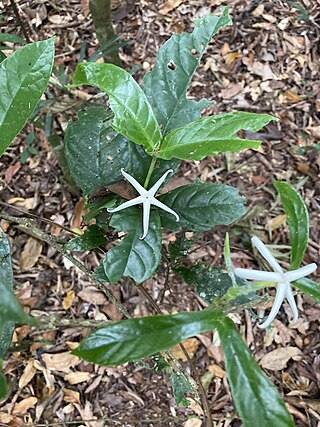
Piper, the pepper plants or pepper vines, is an economically and ecologically important genus in the family Piperaceae.

Black pepper is a flowering vine in the family Piperaceae, cultivated for its fruit, known as a peppercorn, which is usually dried and used as a spice and seasoning. The fruit is a drupe (stonefruit) which is about 5 mm (0.20 in) in diameter, dark red, and contains a stone which encloses a single pepper seed. Peppercorns and the ground pepper derived from them may be described simply as pepper, or more precisely as black pepper, green pepper, or white pepper.

Agathis robusta, commonly known as the Queensland kauri (pine) or smooth-barked kauri, is a coniferous tree in the family Araucariaceae. Although sometimes called a pine it is not a true pine, having leaves rather than needles. It has a disjunct distribution, occurring in Papua New Guinea and Queensland, Australia. Populations in Papua New Guinea may be treated as the distinct species Agathis spathulata.

Long pepper, sometimes called Indian long pepper or thippali, is a flowering vine in the family Piperaceae, cultivated for its fruit, which is usually dried and used as a spice and seasoning. Long pepper has a taste similar to, but hotter than, that of its close relative Piper nigrum – from which black, green and white pepper are obtained.

Ipomoea pes-caprae, also known as bayhops, bay-hops, beach morning glory or goat's foot, is a common pantropical creeping vine belonging to the family Convolvulaceae. It grows on the upper parts of beaches and endures salted air. It is one of the most common and most widely distributed salt tolerant plants and provides one of the best known examples of oceanic dispersal. Its seeds float and are unaffected by salt water.

Schinus molle is an evergreen tree that grows to 15 meters. It is native to an area from the Peruvian Andes to southern Brazil. The bright pink fruits of Schinus molle are often sold as "pink peppercorns" although S. molle is unrelated to black pepper. The word molle in Schinus molle comes from mulli, the Quechua word for the tree. The tree is host to the pepper-tree moth, Bombycomorpha bifascia.

Aphanopetalum is a genus of twining shrubs or vines in the family Aphanopetalaceae which are endemic to Australia.

Alocasia brisbanensis, commonly known as cunjevoi or spoon lily, is a species of plant in the family Araceae native to rainforests of eastern Australia. The common name "cunjevoi" derives from the Bundjalung language of northern New South Wales.

Piper novae-hollandiae, known as the giant pepper vine, is a common climber growing in rainforests of eastern Australia. It is related to the pepper plant. It grows north from Mount Dromedary in southern New South Wales to tropical Queensland.

Piper kadsura is an East Asian species of pepper vine. It belongs to the magnoliid family Piperaceae.

Clematicissus opaca, called small-leaf grape, pepper vine, small-leaved water vine, yaloone and wappo wappo, is a small vine endemic to Australia. Pepper vine is naturally found in rocky locales in monsoon forest, littoral rainforest and open forest, and is occasionally grown as a garden plant. The plant is primarily restricted to coastal and sub-coastal regions in Queensland and New South Wales, although it does occur inland, west of the Great Dividing Range, in central New South Wales,
Stephania tuberosa is a plant in the family Menispermaceae which is endemic to Queensland. It grows as a vine with a stem diameter of up to 5 cm (2.0 in) and produces a distinctive large tuber on the ground which can be up to 50 cm (20 in) diameter.

Calamus vitiensis, commonly known as the Dunk Island lawyer vine, solitary lawyer vine or Mission Beach wait-a-while, is a climbing palm in the family Arecaceae. It grows in rainforests from the Maluku Islands east through New Guinea and the Solomon Islands to Fiji and Vanuatu, and south to Queensland, Australia.

Xanthophyllum octandrum, commonly known as Macintyre's boxwood, false jitta, yellow boxwood or sovereignwood, is a slow-growing tree in the milkwort family Polygalaceae which has the potential to reach thousands of years of age. It is endemic to coastal northeastern Queensland, Australia.

Selaginella longipinna, commonly known as the electric fern, is a plant in the spike moss family Selaginellaceae. It is endemic to northeastern Queensland, growing in rainforest and closed forest from Cooktown to near Mission Beach, including the Atherton Tablelands. It is a terrestrial plant forming a dense cover to 40 cm (16 in) high, often near streams.

Selaginella australiensis is a plant in the spikemoss family Selaginellaceae endemic to northeastern Queensland. It grows in rainforest and closed forest from Cooktown to near Mission Beach, including the Atherton Tablelands. It is a low growing and much branched terrestrial plant inhabiting damp shady locations, typically along stream banks.

Selaginella brisbanensis is a plant in the spikemoss family Selaginellaceae endemic to northeastern and southeastern Queensland. It grows in rainforest and wet sclerophyll forest in two very disjunct populations, one centred around Cairns and the other around Brisbane, some 1,400 km (870 mi) south. It is a terrestrial plant growing up to 20 cm (7.9 in) high.

Alstonia muelleriana is a tree in the family Apocynaceae which is native to southern Papua New Guinea and northeastern Queensland.

Atractocarpus merikin, commonly known as the mountain gardenia or merikin, is a plant in the Rubiaceae family endemic to northeast Queensland.

Meiogyne hirsuta is a plant in the family Annonaceae endemic to the Wet Tropics of Queensland in Australia. It is known from only a small number of collections from three widely separated locations in the Wet Tropics, namely Cedar Bay near Cooktown, the lower reaches of Mossman Gorge, and the foothills of the southern Atherton Tablelands in the vicinity of the North Johnstone River.























